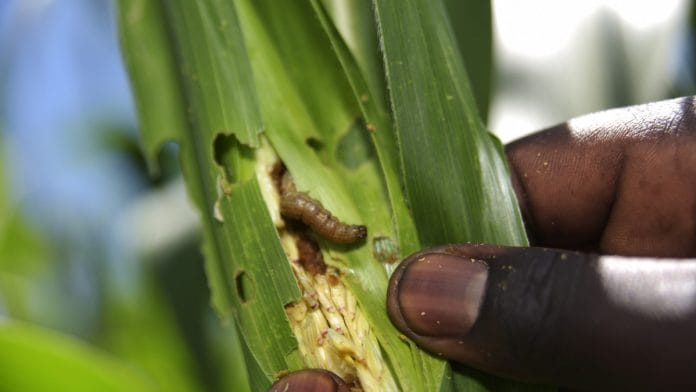Bengaluru: An invasive caterpillar from the Americas that devours crops is fast spreading through India, having marked its presence in 10 states within nine months since the first time it was detected.
The Fall Armyworm (FAW) is currently making its way through the maize fields of southern and eastern India, affecting not just thousands of farmers but also the poultry industry, which relies heavily on the crop for feed.
The insect feeds on leaves and stems of crops such as paddy, sweet corn and sugarcane as well as rice, vegetables, and nearly any produce at all, which is what earned the pest its name.
The insect, originally from the tropical and sub-tropical parts of the Americas, landed in Africa three years ago through imported produce.
It has since destroyed thousands of hectares worth of crops in over 50 countries all over Africa and Asia, affecting millions of lives. Apart from India, the Asian countries affected so far are Bangladesh, Sri Lanka, Myanmar, Thailand, Yemen and China.
Also read: To help Indian farmers, we have to support PepsiCo in its fight for the potato
Initial wave
The caterpillar, Spodoptera frugiperda (‘frugiperda’ is Latin for ‘lost fruit’), was encountered for the first time in Asia last June, in Karnataka.
Entomologists C.M. Kalleshwara Swamy and Sharanabasappa first detected it in the maize fields at the University of Agricultural and Horticultural Sciences, Shimoga. The insect was initially identified as the Northern Armyworm, which is common around the region, but the FAW’s distinct genitalia gave it away.
They are also easily identifiable by farmers. They have a distinct Y-shaped mark on their foreheads, four dots in the form of a square on the penultimate segment of their body, and often random dots on the top side of their body.
Researchers across the country soon took note of the pest as it reached the other southern states before marking its presence in Maharashtra, Gujarat and Chhattisgarh as well. Now, as predicted, it has also been spotted in the east, in Mizoram.
As much as 70 per cent of Mizoram’s population comprises farmers, and the insect has affected over 80 villages in all eight districts since March. According to state officials, FAWs have already destroyed crop worth Rs 18.4 crore.
Researchers from the University of Exeter, UK, have actually warned that the invasion is probably not just tropical anymore and could spread globally, moving on next to Europe, and rest of North America through the warmer and wetter parts of these countries.
There are two genetic strains of FAW: The rice-strain, which feeds on rice, paddy, grass, millets, etc, and the maize-strain, which destroys maize, cotton, sugarcane, among other crops.
Both eat through crops rapidly, as all armyworms do. The FAW is polyphagous, meaning it can feed on many foods — it can eat 186 plant species. Apart from leaves and stems, it also feeds on the flowers of several plants.
The pesticide question
The first recourse against the pest is, of course, pesticide. But because they reproduce so rapidly, they adapt quickly to chemicals.
Pesticides are effective for a few days, and then stop working. Additionally, the overuse of pesticides by desperate farmers is a cause of concern over the toxins’ possible entry into the food chain.
FAWs are cannibalistic, which means they consume each other. But counter-intuitively, this isn’t an effective method to reduce their population or spread — because they consume each other, there is less competition for resources, thus leading them to actually grow faster and stronger.
Birds, mice, and other larger insects feed on the FAW, and are capable of impacting their populations in large numbers.
But these also increase other kinds of damage to crops. The cultural practice of harvesting early, before summer, when the infestation worsens, has helped in South America, but it isn’t feasible in India for the current season since the infestation has already occurred.
The only sustainable method of inhibition seems to be the potential use of biological agents like virus, bacteria, or fungi. While this has been demonstrated in laboratories, a scalable solution is yet to come into India’s fields.
On to sugarcane
Due to shrinking reserves of maize on account of their onslaught, FAWs are now shifting their focus to another crop: Sugarcane.
In October, Karnataka was the first to report this trend, followed by Tamil Nadu in December, prompting the Coimbatore-based Sugarcane Breeding Institute of the Indian Council of Agricultural Research to issue an advisory.
Sugarcane is also said to be under attack in Maharashtra now.
Heavy incidence of #FAW )(Fall armyworm) on sugarcane. Due to the unavailability of the maize the pest shifted on sugarcane. 10 to 15 % damage done by the pest in hot summer @43 ℃ temperature.@FAO @CABI_Invasives @CABI_News @SmartArmyworm @Jabajagdish @icarindia @allanhruska pic.twitter.com/EcQoUJalMQ
— Dr. Ankush Chormule (@Anku_chormule) April 28, 2019
As mentioned earlier, the infestation worsens in the summer, and it doesn’t help that the insect is a strong flier. A FAW’s life cycle lasts 30 days, with 10 to 20 days of adulthood, during the summer and longer during other seasons.
In the first 10 days of its life, FAWs eat very little, but consume 50 times that amount over the next 20. As a result of the heat, the worms are currently reproducing fast and colonising faster.
In Maharashtra, where the insect has also affected vast swathes in the drought-hit Vidarbha region, the prices of maize have gone up drastically due to scarcity, and the FAW infestation is one of the strongest contributing factors.
In Chhattisgarh, FAWs are also consuming paddy, chickpea, jowar, and groundnut, according to a report in Down To Earth.
Also read: How MS Swaminathan, father of India’s Green Revolution, got GM crops ‘all wrong’






